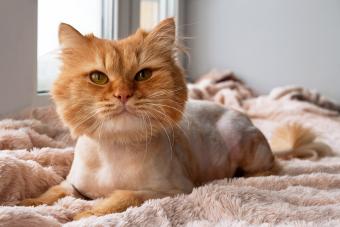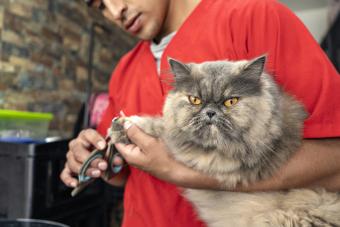
If you have a long-haired kitty, there are times it may make sense to take them to a groomer who specializes in lion cuts for cats. Lion cuts aren't always the right choice, but this method of shaving a cat's body and leaving their face and neck fur intact can be beneficial during especially hot seasons or if your cat is prone to mats. Let these pros and cons of the lion cut help you decide whether to pursue this look for your kitty.
Cats Shaved Like Lions
A lion cut is the fur style given to long-haired cats where the body of the cat is clipped nearly down to the skin. There are a few variations of the cut, but the basic look leaves the cat with very short fur on their body and legs, while the face, neck, and most, if not all, of their tail are left alone.
Variations on the Lion Cut
There are a few variations on the cut. All lion cuts leave the cat's face and neck alone, but some variations can include:
- Shaving the entire leg and top of the paws
- Shaving only the top half of each leg, leaving a thick, hairy "boot" on each paw
- Leaving the fur on the tail long
- Shaving most of the tail, leaving only a small pom-pom of fur at the very end
- Leaving the chest hair intact as part of the "mane"
- Leaving a strip of fur along the spine for a dino cut
- Shaving the rear but leaving hair on the shoulders, chest, and front legs, known as a bolero cut
How Long Before the Hair Grows Back?
If you give your cat a lion cut for the first time and decide that you and your cat would be happier going back to their natural look, you can expect their hair to grow back fully over the course of a few months. For a short-haired breed, it should take about three months on average. A long-haired cat may take as long as six months to return to their full-length coat.
Why Give a Cat a Lion Cut?

While cats sporting a lion cut certainly have style, this is not generally the reason the cat is shaved. There are several reasons why it may be a good idea to give your cat this cut, at least temporarily.
Pro: Easier Maintenance
Long-haired cats need a great deal of grooming. While most cats do self-groom, long-haired breeds require more care. Their fur should be brushed or combed on a weekly basis to help with shedding and reduce mats. Busy cat owners may find that clipping their long-haired cats into a lion cut can help cut down on the required amount of grooming.
Pro: Eliminate Mats
If a cat is not brushed regularly or has a hard time with self-grooming, mats may build up in the fur. If these mats are left alone, they may twist, pinch, or otherwise harm the skin beneath them, leading to uncomfortable skin irritation and open wounds. Cats that develop frequent mats or that have fur that has become heavily matted can be given a lion cut to help deal with the problem.
Pro: Minimize Hairballs
During warmer weather as your cat begins to shed, your long-haired breed may be at a higher risk of developing hairballs. As the cat grooms their shedding fur, they may ingest more than can be safely passed through their digestive system. This can lead to hairballs, vomiting, choking, constipation, or bowel obstructions that require surgery. Clipping the fur into a lion cut often eliminates this problem.

Pro: Address Excessive Heat
If you live in a warm climate, your long-haired cat may have difficulty dealing with the heat. Just like dogs, cats are susceptible to life-threatening heatstroke if they become overheated. Lion cuts greatly reduce the amount of hair on a cat, which can help them stay cooler during the hotter months, though many veterinarians state the benefit is negligible.
Pros: Aids With Self-Care
If your cat is older or obese, they may have difficulty keeping themselves clean and well-groomed. Cats with longer fur may have increased difficulty with self-care as they age because they may not have the flexibility to reach all their fur. Finally, some cats, strange as it may seem, are just bad at self-grooming. Clipping them into a lion cut can help your cat self-groom more effectively.
Pro: Reduces Shedding
Giving your cat a lion cut won't actually reduce the amount that they shed, but since the hairs will be much shorter, it will seem to you like there's less hair being deposited around the house. This can be a boon for some human allergy sufferers, as well.
Problems With the Lion Cut
While the lion cut is largely beneficial to both cats and their owners, there can be a few drawbacks.
Con: Potentially Stressful for the Cat
Some cats may not object to being shaved, but it may be a stressful situation for others. Lion cuts are usually given at a veterinary office or pet groomer, which means a trip in a car and an unfamiliar situation for your cat to be in. The anxiety may be so great for some cats that they need to be sedated before being clipped. This should always be done under the guidance of your veterinarian.
It's also possible for cats to feel very uncomfortable and anxious after their clip due to such a significant change to their body. You may see them display unusual symptoms such as hiding, refusing to eat, and depression.
Con: Expense
If you keep your cat in a lion cut for long periods of time, the expense can add up. Depending on how thick your cat's fur is, how fast it grows, how fast mats or other problems develop, or whether they need to be sedated for the clipping, you may be looking at monthly trips to the groomer or vet. The cost can run, on average, from $80 to $120 or more for each visit.

Con: Sunburn Is a Hazard
If you have a cat that goes outdoors, a lion cut can make their skin much more accessible to the harmful rays of the sun, which means irritated skin and sunburns. Cats with paler fur and pink skin will be at even higher risk. This isn't related to season either, as a cat can be sunburned and windburned in the winter as well as the summer. Cats that are shaved also have vulnerable skin overall, which means they can get more cuts, scrapes, and other irritations without their fur to protect them. If you're going to give your cat a lion cut, it's best to keep them indoors all year round.
Con: Inability to Regulate Body Temperature
One of the ways that animals, including cats, maintain their body temperature is through their fur. While a cat that's been shaved may be cooler in the summer, it's possible they can actually become overheated or too cold if they lose their ability to thermoregulate. Senior cats and sickly cats are at an increased risk for this problem if they're shaved. Certain medical problems like cancer and heart disease may make shaving inadvisable.
Keep Your Cat Comfortable
For many long-haired cats, a lion cut can help with some of the problems that long-haired breeds face. Consider getting your cat clipped if any of these issues arise, and enjoy their new look while it lasts.







